Fuller clashes narrative modes (romance, action, exposition) across and within scenes.
Like the layout of different stories on a newspaper page ("Co-Ed Murder Suspect to Tell All," "Saw Parade of Beauties Unclad in Worker's Room," "Furriers Fail to Quit in Needle Strike" [The Graphic, June 20, 1929, 5]), the overall presentation of a Fuller film often shifts from one narrative mode to another. Fuller's aesthetic largely presents sentiment (blue: romance) as something to be buried, repressed through the contrapuntal shock edits of violence, or the sudden emotional explosions within a scene (red: action).
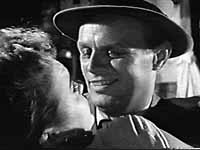 Pickup on South Street (1952). Two scenes with Jean Peters (Candy) and Richard Widmark (Skip McCoy) move from tenderness to violence. The first begins in an expository mode--she asks how he became a pick-pocket. The camera rapidly cuts to a reverse shot of Widmark. Enraged, he shoves her away. "How did I become a pick-pocket? How did you become what you are?" The second scene starts with exposition (a discussion of Mo's death) as Peters cries. Widmark, angry, butts his cigarette on the floor, moves away and snaps, "Aw, shut-up." Then he pauses, feels a tenderness and apologizes. But, moments later when he decides to sell government secrets to the communists: "He better have that 25 grand ready," blue and white are eclipsed by red. Peters smashes a beer bottle over his head and becomes our moral center. These radical switches in mood reflect the irrationality of Fuller's universe.
Pickup on South Street (1952). Two scenes with Jean Peters (Candy) and Richard Widmark (Skip McCoy) move from tenderness to violence. The first begins in an expository mode--she asks how he became a pick-pocket. The camera rapidly cuts to a reverse shot of Widmark. Enraged, he shoves her away. "How did I become a pick-pocket? How did you become what you are?" The second scene starts with exposition (a discussion of Mo's death) as Peters cries. Widmark, angry, butts his cigarette on the floor, moves away and snaps, "Aw, shut-up." Then he pauses, feels a tenderness and apologizes. But, moments later when he decides to sell government secrets to the communists: "He better have that 25 grand ready," blue and white are eclipsed by red. Peters smashes a beer bottle over his head and becomes our moral center. These radical switches in mood reflect the irrationality of Fuller's universe.
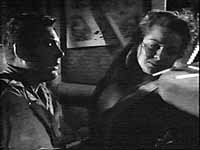 China Gate (1957). After killing a Viet Minh in an observation post, American Gene Barry (Brock) and Asian Angie Dickinson (Lia "Lucky Legs" Surmer) reconcile over the dead body. They kiss and speak softly. Dickinson looks forward to having their child emigrate to the United States. Barry, embarrassed by the boy's almond-shaped eyes, breaks the mood and says, "That's not what I had in mind." Dickinson, half-lit in shadow, separates from his hold. "The wrong man was killed in here tonight. Tell the captain to send up a human being." Fuller breaks the romantic mood, not with violence, but the threat of emotional violence behind Barry's racial hostility.
China Gate (1957). After killing a Viet Minh in an observation post, American Gene Barry (Brock) and Asian Angie Dickinson (Lia "Lucky Legs" Surmer) reconcile over the dead body. They kiss and speak softly. Dickinson looks forward to having their child emigrate to the United States. Barry, embarrassed by the boy's almond-shaped eyes, breaks the mood and says, "That's not what I had in mind." Dickinson, half-lit in shadow, separates from his hold. "The wrong man was killed in here tonight. Tell the captain to send up a human being." Fuller breaks the romantic mood, not with violence, but the threat of emotional violence behind Barry's racial hostility.
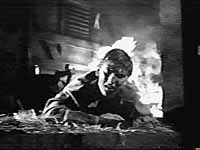 Verboten! (1958). James Best (David) and Susan Cummings (Helga Schiller) reconcile. As they embrace, Fuller crosscuts from their romance to twelve year-old Harold Daye (Franz) fighting a nazi, Bruno, in an abandoned railroad car. The car goes ablaze. Fuller continues crosscutting, marring the traditional Hollywood ending of a lovers' embrace with juxtapositions of a death struggle against racist ideology.
Verboten! (1958). James Best (David) and Susan Cummings (Helga Schiller) reconcile. As they embrace, Fuller crosscuts from their romance to twelve year-old Harold Daye (Franz) fighting a nazi, Bruno, in an abandoned railroad car. The car goes ablaze. Fuller continues crosscutting, marring the traditional Hollywood ending of a lovers' embrace with juxtapositions of a death struggle against racist ideology.
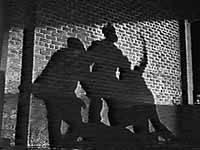 Underworld USA (1961). Fourteen year-old Tolly meets Sandy in back of her club. She dresses a wound on his face and gives him a polka-dot tie for New Years. Auld Lang Syne plays on a musical doll and a moment of communion occurs between a woman who can't have children and her surrogate son. Suddenly Fuller collides blue with red in a gritty crosscut. Sentiment is marred as we move from the gift-giving to long angular shadows on a brick wall and Tolly's father being beaten to death in a back alley.
Underworld USA (1961). Fourteen year-old Tolly meets Sandy in back of her club. She dresses a wound on his face and gives him a polka-dot tie for New Years. Auld Lang Syne plays on a musical doll and a moment of communion occurs between a woman who can't have children and her surrogate son. Suddenly Fuller collides blue with red in a gritty crosscut. Sentiment is marred as we move from the gift-giving to long angular shadows on a brick wall and Tolly's father being beaten to death in a back alley.
Part 2a: EXPOSITION.
At the story level, Fuller's characters make relevant social statements.
Film narratives, according to narratologist Chatman, are comprised of a system of intelligence, a series of textual cues that we put together while viewing. Within these textual cues rests both a narrator and filtered characters. The narrator exists only on the discursive plane and works in conjunction with the film's presentation to give us a slant, a point-of-view on the cinematic story. Characters work within the story plane to give the viewer first-hand, as opposed to the narrator's reported perception, emotions to the events. Fuller's characters often provide viewers with the tabloid's editorial aesthetic: judgmental commentary about our society.
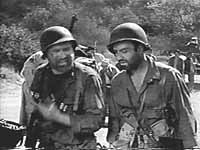 Steel Helmet (1950). Many of the appalling comments of Sgt. Zack (Gene Evans) anticipate the accounts of Viet Nam veterans. On killing two "nuns": "These red guerrillas dress like women, huh?" On knowing the enemy: "He's a South Korean when he's running with ya. He's a North Korean when he's running after ya." Fuller's text also boldly addresses race relations during the conformist 1950s. A captured communist goads James Edwards (Thompson, a black medic) on how he can't ride at the front of a bus and later reminds Richard Loo (Sgt. Tanaka, an American Nisei) of how Japanese-Americans were interned during W.W.II. These forthright comments by Fuller reflect the newspaper reporter's drive to tell the truth about guerrilla warfare and expose America's own egalitarian short-comings.
Steel Helmet (1950). Many of the appalling comments of Sgt. Zack (Gene Evans) anticipate the accounts of Viet Nam veterans. On killing two "nuns": "These red guerrillas dress like women, huh?" On knowing the enemy: "He's a South Korean when he's running with ya. He's a North Korean when he's running after ya." Fuller's text also boldly addresses race relations during the conformist 1950s. A captured communist goads James Edwards (Thompson, a black medic) on how he can't ride at the front of a bus and later reminds Richard Loo (Sgt. Tanaka, an American Nisei) of how Japanese-Americans were interned during W.W.II. These forthright comments by Fuller reflect the newspaper reporter's drive to tell the truth about guerrilla warfare and expose America's own egalitarian short-comings.
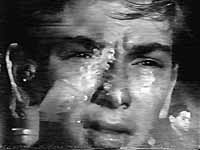 Verboten! (1958). Twelve-year old Franz is taken by Helga to see the Nuremberg War Trials. Helga has discovered that Franz is a member of the Werewolf, a pack of Hitlerite, and she wants to convert him. At the trials Franz is forced by Helga to watch an expository essay film. The film within the film, through a series of graphic images, reveals nazi atrocities: gassings, intolerance. Franz cries, "I didn't know." Helga becomes a substitute for Fuller in this scene, embodying the reporter's desire to make us look, make us know and make sure we never let the Holocaust happen again.
Verboten! (1958). Twelve-year old Franz is taken by Helga to see the Nuremberg War Trials. Helga has discovered that Franz is a member of the Werewolf, a pack of Hitlerite, and she wants to convert him. At the trials Franz is forced by Helga to watch an expository essay film. The film within the film, through a series of graphic images, reveals nazi atrocities: gassings, intolerance. Franz cries, "I didn't know." Helga becomes a substitute for Fuller in this scene, embodying the reporter's desire to make us look, make us know and make sure we never let the Holocaust happen again.


























